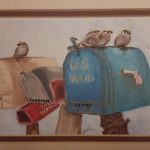This is my final blog post on this website. While I did not manage to post every week as intended, I did as much as I could. This post is a defense of the USAO Contract regarding our project site for The Catcher in the Rye – Catching Their Ire.
Tools Used
WordPress was obviously used and was helpful in our project. Robert and I both have experience working with the site prior to this class, he specifically with the Pique theme, and I feel it worked well. There were occasional difficulties with my understanding of the drop-down menu as when I added a page a certain function would allow or disallow the page to jump straight to the top bar, causing a bit of frustration. This is part of why our pages were published so late was to avoid this background issue. Pages would sit in the back as we finished them in order to allow for a bulk of finished pages to appear on the site in their proper places.
Storymap.js was used to show where Catcher was banned between the ’60s and ’80s. This map displays how far flung the challenges were and gives hints as to other cases. Because they would require as much or more digging than our personally chosen case, we decided not to focus on fleshing out the other challenges and leaving it up to individuals who visit the site to choose which challenge they are personally interested in and look into it.
Coggle was used in the background to organize our ideas initially. As we delved further into the project, it was tossed to the side. We mainly kept each other accountable through discussions over messages or emails.
Gimp 2 was our primary source of picture editing when it comes to the newspaper articles. Articles were copied, sometimes more than one to a page for simplicity, and needed cleaned and labeled once scanned into the computer. This experience allowed me to get a better feel for Gimp, which I hope to use on a personal basis.
Online Databases gave us a good chance to find information. Unfortunately, a majority of the information found may not have been used.
OneNote2016/Evernote were somehow difficult for me to use and due to continual email errors which were experienced, we ditched the programs.
Division of Labor
The legislative and historical context became one and the same, aside from synopsis and biography. As such, the legislative section may not be as fleshed out as previously hoped for, however there is context provided as to the racial tension of the 1960’s. While this is not necessarily tied in to the Tulsa case, it is important to note any kind of political tension can cause tempers to flare. The synopsis page, while short, is exactly what we said it would be. A brief introduction for those who have not read the book.
The StoryMap, as discussed above, was to discuss the bannings of a 20 year span. The commonality found was profanity and obscenity, we are hoping that as this site is more targeted toward high school or college level and above audiences they will be able to deduce the thread between bannings.
All transcriptions were done by hand and uploaded to SoundCloud for a clean appearance. While typos occurred, that is to be expected and cannot always be fully avoided. These interviews did not have much to say about our case in particular, though they do highlight the contexts of Catcher in the Rye and Oklahoma as a state.
Milestones
I don’t recall if I really made any of the milestones aside from having a completed rough site and now having a final site. This semester was a wild ride from start to finish with many large projects that kept battling each other for my undivided attention. I put the most time out of all of them into this class and I hope it shows in this final site.






